Affiliate link disclosure – The BMW Repair Guide uses affiliate links in their site. For more information on affiliate links, please click here.
- Repair Summary
- Repair Difficulty and Cost
- Repair Video
- Parts Diagram
- Required Parts List
- Repair Steps
Repair Summary
This is the first of several articles in our series on diagnosing and repairing BMW rough idle issues in BMW vehicles. Even though we used a 2006 530xi touring wagon to perform this repair, this article can be applied to any BMW vehicle with minor modifications to the repair steps.
See all vehicles this article applies to
All BMW Models
Approximately 90% or more of all BMW rough idle diagnoses are caused by vacuum leaks.
Yes...you read that correctly. Ninety percent. And we feel that is being conservative. We have worked on hundreds of BMWs here at the Repair Guide, and without any doubt, the number one reason for a BMW rough idle on startup is due to unmetered air being introduced into the cylinders. In other words, a vacuum leak in the intake system allowing air to enter the engine without being "measured" by the mass air flow (MAF) sensor.
We have written many articles dealing with vacuum leaks and rough idle issues, but we have yet to discuss the most important piece of the puzzle: how to diagnose the leak and determine how to fix it. Unfortunately, there are many potential failure points in the BMWs engine that can allow unmetered air into the intake manifold and into the cylinders. The proper technique in repairing a BMW rough idling engine is to find vacuum leaks without randomly replacing parts that are not broken...which is a complete waste of money and time.
Why do vacuum leaks cause your BMW to rough idle?
We could dedicate an entire article discussing the physics behind unmetered air induction into the cylinder head...but we will keep it simple. The BMWs engine management system consists of an engine control module (ECM) that continually makes adjustments to the air/fuel mixture being sprayed into the cylinders. These adjustments are calculated based on comprehensive data from an array of sensors throughout the engine itself. One of the most critical of these data measuring devices is the mass air flow sensor, most commonly called the MAF. The MAF is located just downstream of the air filter and its job is simple. It measures the exact amount of outside air being funneled into the engine and transmits this data to the engine management system. The ECM uses this data to adjust the amount of fuel being sprayed into the cylinders, allowing our BMWs to run as smoothly and efficiently as possible.The proper technique in repairing a BMW rough idle on startup is to find vacuum leaks without randomly replacing parts that are not broken.
But what happens if we have a cracked vacuum hose or a leaking intake pipe? Now we have air being sucked into the engine that was not measured by the MAF (unmetered air). The ECU has no idea there is a leak so the engine starts running lean from too little fuel causing an irregular idle and poor engine performance. Often the ECM will realize there is an issue and will try to compensate with increased fuel flow causing the engine to run too rich. This bouncing back and forth between fuel/air mixture can be visually seen in the RPM needle as the rough idling engine tries to correct itself in vain.
Where are most vacuum leaks located and what causes them?
This is unfortunately a difficult question to answer since there are many parts associated with the air management system. That being said, based on the data we have compiled over the years here at the BMW Repair Guide, most vacuum leaks that cause a BMW rough idle on startup are usually found in the intake boot or piping connecting the air filter assembly (intake muffler) to the throttle body. The second most prevalent source is the hard plastic tubes that comprise the crankcase breather system. Over the years these rubber and plastic parts become hard and brittle from the heat in the engine compartment...causing them to crack. It is also very common for older hoses and pipes to fracture or become knocked loose by mechanics working on the engine, or from a hard jolt to the vehicle from hitting a pothole or curb.Some intake vacuum leaks do not cause error codes and dashboard lights, making them especially difficult to pinpoint.
Sometimes vacuum leaks can come on fast and furiously. We have had readers email us with stories of pulling out of the garage with their BMW functioning normally, only to barely get it to the end driveway before the car barely runs.Diagnosing a vacuum leak
Over the years mechanics have come up with many interesting ways to find vacuum leaks in BMW intake systems from "bubble" testing with soapy water, rigging up contraptions that pressurize the system with cigarette smoke, or injecting the system with propane (which we feel is complete insanity). We will be very blunt...none of these will correctly diagnose a vacuum leak.
The BMW Repair Guide only recognizes the use of an automotive EVAP smoke testing machine with the proper test fittings to diagnose vacuum leaks. If you are a BMW enthusiast or home mechanic who plans to work on your own vehicle, invest in a decent smoke test machine. It's as important as a diagnostic scanner and can be used for many other repairs from coolant and fuel system leaks to fixing cracked weatherstripping and windows that aren't sealed tight.
Which smoke testing machine should I buy?
Automotive smoke testing machines range in cost from about $100 to over $3000. What's the difference? Pretty much just the bells and whistles. A $100 smoke machine does the same job as a unit that costs 30 times more - it pumps pressurized smoke. The difference is usually in what options it has. More expensive units are usually made for professional repair shops and often provide higher and denser smoke output, diagnostic gauges or screens, and more advanced controls. They are a wonderful addition to any home mechanic garage but are often beyond what most owners want to spend.Luckily there are many fine smoke machines on the market that can be purchased for under $200. These smoke testers may be minimalistic in design but do a perfect job in finding intake leaks. Many do not come with diagnostic plugs and adapters, but these can be purchased relatively cheaply in addition to the tester.
Please see our parts block below for our top choices in affordable automotive smoke testing machines for your BMW.



If the video does not appear below, please click here to view
View the video version of this repair.
View the detailed parts diagram for this repair.
Includes detailed part diagrams, part numbers and links to purchase all of the required components needed to complete this repair.

Before starting this repair, you must have the following required parts.
All BMW Models
Professional quality smoke tester at an affordable price. Works on all systems including intake, fuel, and cooling. Comes with adapters.
All BMW Models
A cone adapter is an absolute necessity for smoke testing the intake or cooling systems on your BMW. It is the only proper way to seal off the intake boot without creating annoying leaks.
All BMW models
16 piece set. Assorted caps and plugs for sealing off the intake or cooling system for smoke testing.
Section 1 - Diagnosing an intake system vacuum leak part 1
As discussed at the beginning of this article, there can multiple sources of a vacuum leak in your BMW's air intake system. The only way to determine the source is by smoke testing the system. When smoke testing the intake system on your BMW, always start as far upstream as you can (as close to the air filter you can get). Remember that any leaks on the air filter side of the mass air flow sensor will not affect engine performance and do not have to be addressed (see diagram below).Background on this test - Our 2006 530xi took a VERY hard jolt to the front end when we ran over a curb in a local parking lot. The engine immediately began to run rough and exhibited very poor acceleration. A brief visual inspection did not show any loose vacuum lines so we smoke tested using a cone adapter and plastic plug as detailed below.
- Always begin your smoke test as far upstream as you can in the air intake system. The preferred location to begin is at the mass airflow sensor, if possible. Remember that the exact location and how you get there will differ among BMW models. These steps should serve simply as a guide.
- Our 2006 530xi has the N52 six-cylinder engine. Since we are dealing with a BMW rough idle on startup, we will start our test at the intake muffler (air filter housing) and work our way downstream towards the cylinder head.

- Remove the intake muffler and disconnect the mass air flow sensor so a rubber cone adapter can be inserted inside the intake boot.
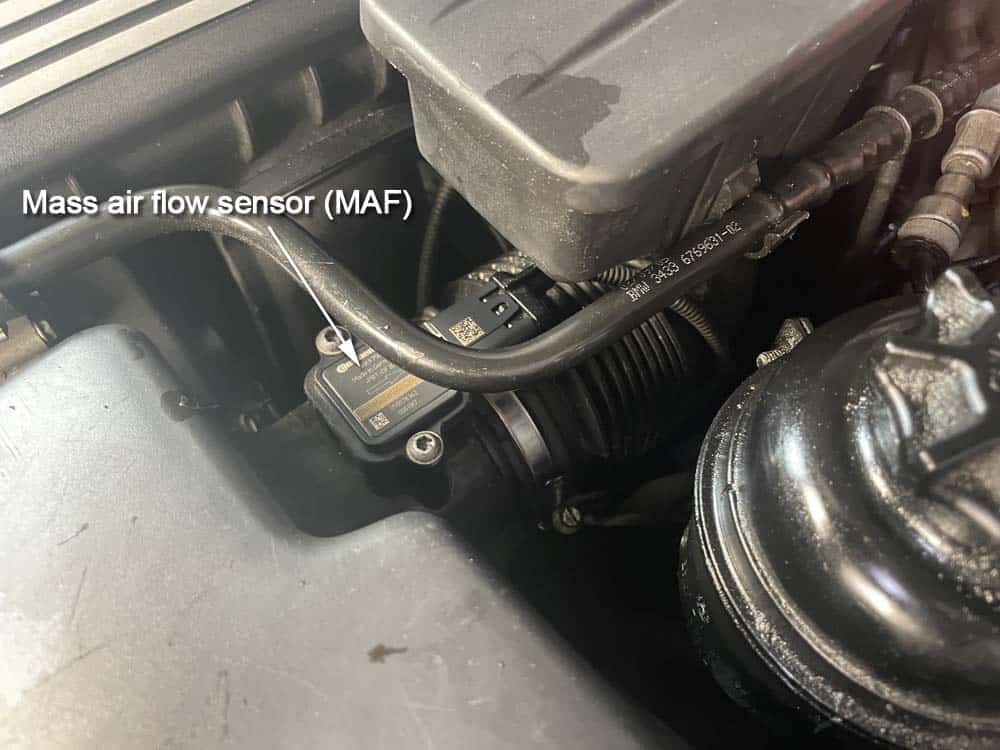

- Firmly install the rubber cone adapter into the intake boot.
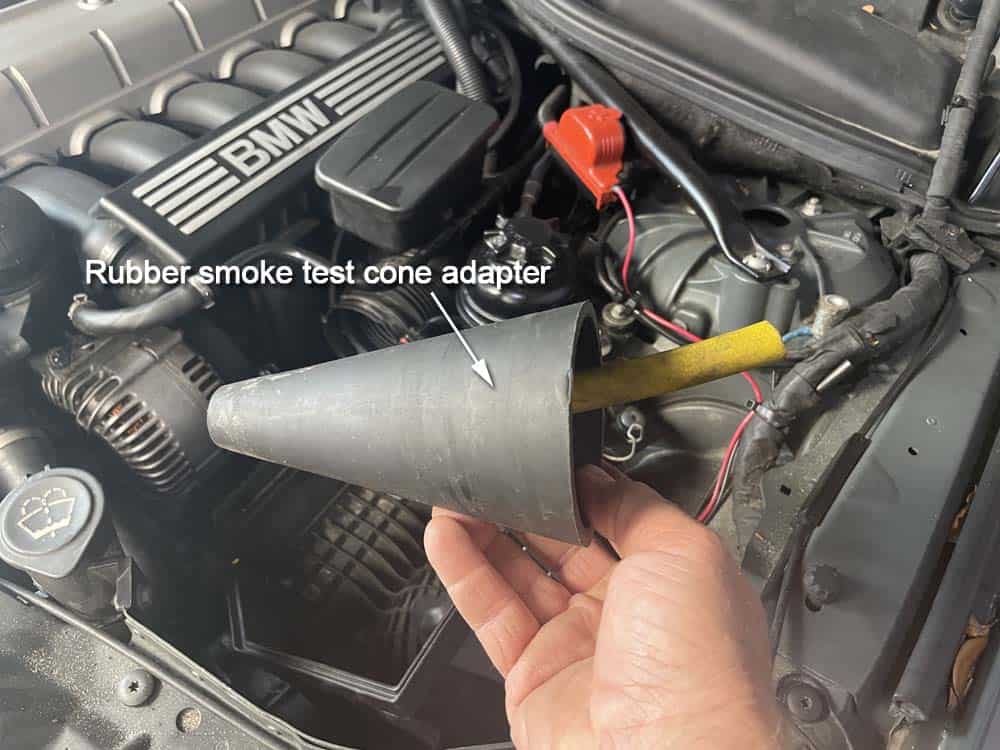
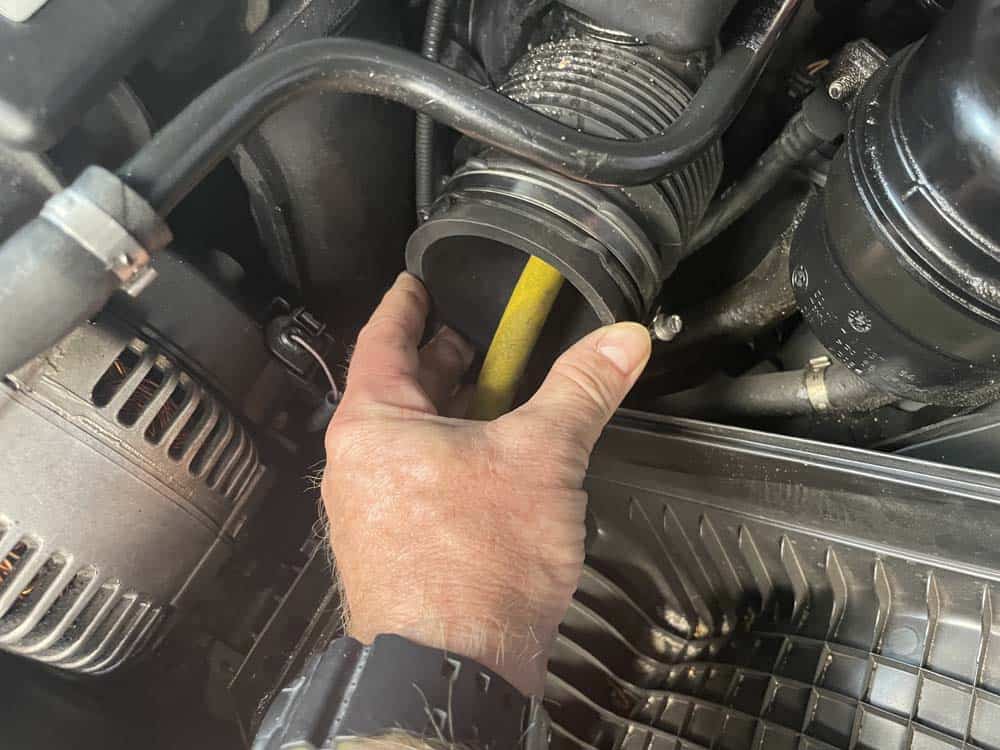
- Connect the smoke tester to the positive and negative battery terminals in the engine compartment and to an air compressor. Verify the smoke tester is on and is producing smoke. Always verify the machine is producing smoke before attaching it to the adapter!



- Turn off the smoke and attach the nozzle to the cone adapter.

- Make sure the cone adapter is snug and turn the smoke back on. Look for any smoke leaks in the intake boot or around the intake manifold. If there is a leak it will quickly be evident.
- Our leak was quickly visible. Smoke began pouring out of the intake boot where it attaches to the throttle body.
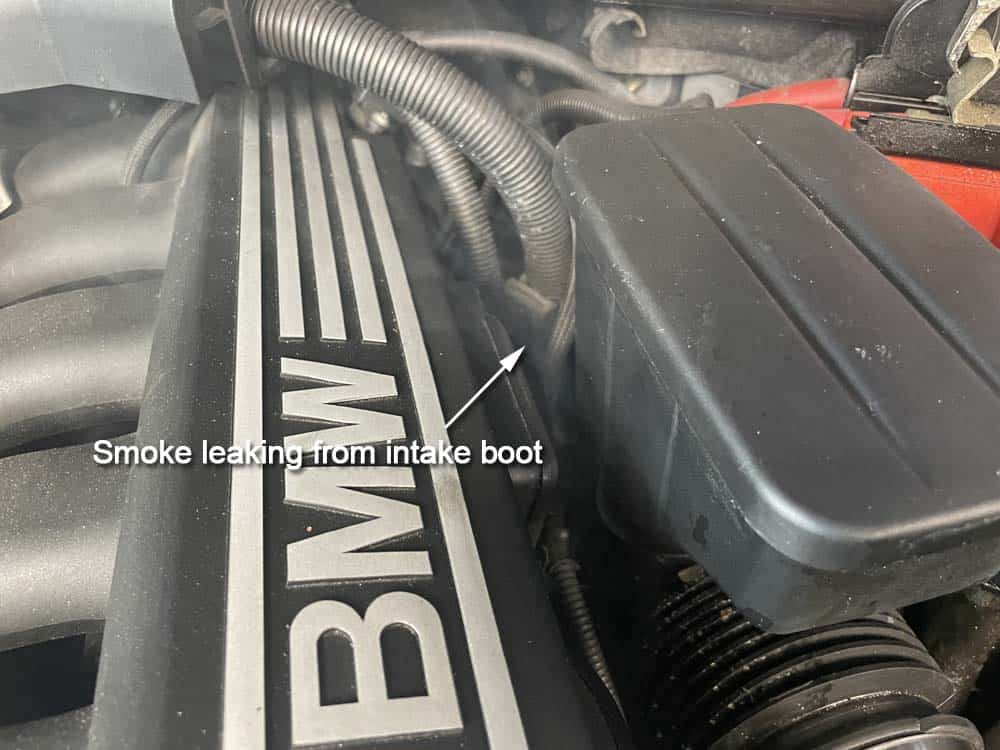
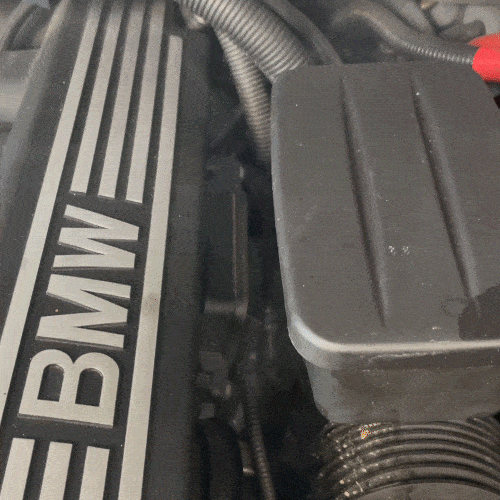
- Remove the intake boot from the throttle body and inspect for any cracks. BMW engine intake boots are infamous for drying out and cracking...especially in the flexible section.
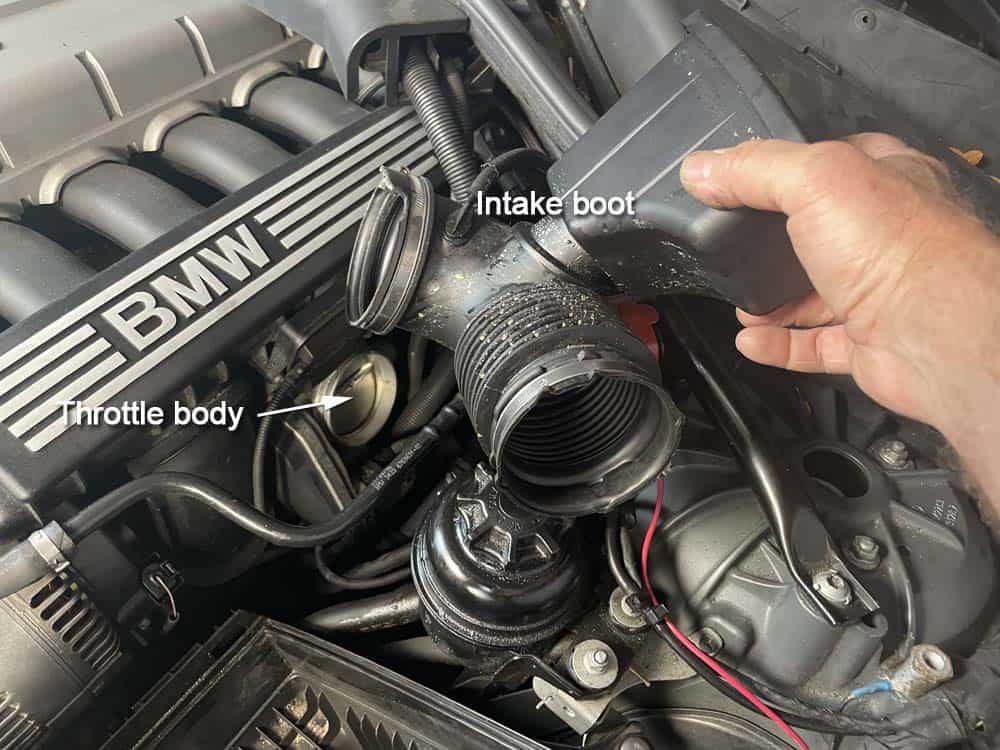

- After further investigation, the impact of hitting the curb caused the hose clamp on our intake boot to come loose from the throttle body allowing unmetered air to enter the engine. In fact, the hose clamp fell apart when we were removing it as shown below. We installed a new hose clamp and the rough idle was cured.

Section 2 - Diagnosing an intake system vacuum leak part 2
The next step in diagnosing an intake system vacuum leak is to test the system from the other end. Even if you find a leak in the intake boot in section 1 above, you should complete this step. There could be other leaks that may not be visible when testing from the intake boot.- Begin by removing the engine covers from the top of the engine. We do this so we can get a clean unobstructed view of the intake manifold gaskets and piping.

- You should have a good set of diagnostic caps/plugs in your smoke test kit like the ones below. If you don't, please see our parts list above to order.

- Remove the oil filler cap and its plastic mounting ring from the valve cover. The mounting ring must be removed to get a nice clean seal for the test cone in the next step.

- Flip the diagnostic cone over and insert it into the oil fill opening as shown below. Insert the smoke tester nozzle into the top of the cone.

- While using one hand to press down on the test cone, fill the system with smoke.

- When you verify the smoke has reached the throttle body, turn the smoke machine off and install a test plug into the throttle opening as shown below.


- Turn the smoke machine back on and look for leaks in the intake manifold gaskets, crankcase breather lines, vacuum lines, and other piping. This is a great way to also find oil leaks in the valve cover gasket.
Section 3 - Conclusion
There are multiple points for possible intake manifold vacuum leaks in a BMW rough idling engine, especially around the intake boot and throttle body. Look for any cracked tubes or pipes...especially plastic ones. The intense heat in the engine compartment combined with age causes plastic and rubber piping to become brittle and break. The intake system on your BMW must be air tight to avoid a rough idling engine.Rough Idle on Startup Diagnoses and Repair Finished

